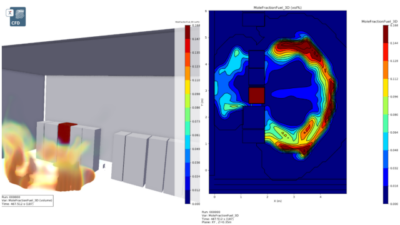With spring coming into full bloom, and of course, the recent observance of Earth Day, it’s an appropriate time to consider the state of sustainable design and LEED—Leadership in Energy and Environmental Design.
In a meeting last week with CSE advisor Anil Ahuja of CCJM Engineers, Chicago, we spoke of his company’s work in this area, which is significant, including a trio of schools in the far northern suburbs and the new Ford Calumet Center on Chicago’s Southeast side—a former heavy industrial area in a wetland environs. In fact, CCJM is currently working on a total of 10 LEED-hopeful projects.
But despite the seeming cornucopia, Ahuja, a LEED-Accredited Professional, thinks firms aspiring to enter the green market need to go into the process with their eyes open and be prepared to get their hands dirty with a lot of hard work.
“Developers, for the most part, just don’t care about LEED,” he said. “They just don’t see how they’re going to get more rent money by doing so.”
For the most part, he’s found that green backers are generally owners who are committed to the environment. That’s exactly the case with the private schools CCJM is working onin the north suburbs.
“The bottom line is that engineering on a LEED project costs more than a traditional job, and a lot of clients don’t see the value of providing the extra engineering fees,” he said.
LEED, itself, with its extensive documentation process, can also be daunting. “We often spend a lot of time discussing sustainable features and achieving LEED certification. But the fact is that these items often get dropped in the value engineering process, as many clients simply can’t afford it,” said Ahuja.
So what’s one to do? If you are committed to sustainable principles, Ahuja believesyou’ve got to put in as much time educating yourself about potential clients as you do in understanding sustainable technologies. Government, at all levels, and most visibly at the federal level, is also an excellent green prospect. But getting in good with the government also means being an active member of the community. For example, CCJM is very involved with the general green efforts of Chicago. Just recently, Ahuja was involved in a brainstorming session with city officials who were attempting to come up with incentives to get local owners, designers and builders to go green. One idea Chicago is contemplating is an expedited permit process for those who include green elements in their construction plans.
On the subject of sustainable technologies, CCJM has been experimenting with chimney-style wind generators for on-site power. Instead of the colossal propellers most commonly associated with wind power, CCJM has found that these much smaller devices work equally well on a roofs. They’re also especially appropriate in any kind of retrofit application where old chimneys can be repurposed. Granted, the technology works best depending on the size of the roof and the height of the building. CCJM is currently employing this technology, as well as geothermal, on the Ford project to take advantage of the site’s surrounding abundance of water.
Surroundings, including climate, also have a significant bearing on green technology. In places like Chicago, where there are extremes in both summer and winter, Ahuja noted supplemental heating and cooling would also need to be added.
In-house training and housekeeping are also critical, according to Ahuja. For example, to take advantage of natural ventilation with more operable windows, he said facility staff must make sure windows are open or closed. Such systems could be automated, of course, but Ahuja quickly pointed out that this adds cost to the buildings, a tricky subjectto start with.
Designers, he added, must also be smart as to how they apply green technology. Daylighting, for example, is a great sustainable technology, but if sensors are placed in the wrong positions, Ahuja said the constant switching of the lights on and off becomes a nuisance.
Finally, designers must also be prepared to be green, but not necessarily LEED-certified. In other words, for clients who rule out LEED because of costs or frustration during the process, it’s still no reason to abandon good or green technologies where they’ll be a service both to the client and the environment.
In general, he feels that more engineers need to get on the green bandwagon. Right now, he said, architects outdo engineers in LEED accreditation by nearly a 5:1 margin. And, he added, if you want to get LEED jobs, you’d better be at the same speed of the architects conceiving such projects.
And of course, sustainable design is not all cutting-edge or funky technology. “It all boils down to ASHRAE 90.1—it’s at least half the credits alone,” Ahuja said.
Besides sustainability, reliability is a major trend for many engineers. These two, however, seem to be at odds. “I get RFPs right and left requesting 15 or 25 watts per sq. ft.,” said Ahuja. “It’s hard to be sustainable when you have such power demands, especially when standards for‘good’ sustainable design call for no more than 2 watts per sq. ft.”
Ahuja said it’s a shame that technologies such a fuel cells have not come to fruition and seem doomed to never mature. But that being said, it doesn’t mean data center-type projects can’t be more sustainable.
In fact, he said, the industry really needs to come together to reconcile these forces, as they need not be mutually exclusive; self-generation technologies, be they cogen or solar power, have a lot to offer, as do other not-as-eco-friendly distributed-generation technologies. It’s more about the goal of buildings becoming self-generating and sustaining, said Ahuja, but it has to start somewhere.



